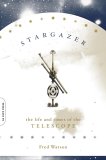Summary | Excerpt | Reviews | Beyond the Book | Readalikes | Genres & Themes | Author Bio

Critics' Opinion:
Readers' Opinion:
First Published:
Jul 2005, 360 pages
Paperback:
Jun 2006, 352 pages
 Book Reviewed by:
Book Reviewed by:
BookBrowse Review Team
Buy This Book
But on the final day of the Munich symposium, in a session
entitled 'Extremely Large Telescopes', a capacity audience was stunned to learn
just how far this line of reasoning had progressed. The logic went like this: if
segmented-mirror technology would allow a 25 metre telescope to be built, why
not a 50 metre one? Or even a 100 metre one? Surely the remaining engineering
challenges were just . . . engineering? Wasn't it merely a question of adding
more segments to the mirror and building a bigger structure to support it and
point it in the right direction? So, with the kind of pizzazz normally reserved
for the launch of next year's BMW sedan, a project called OWL was ceremoniously
launched into the astronomical world.
OWL was to be a telescope of no less than 100 metres aperture
with a mirror made up of hexagonal segments measuring 2.3 metres across—a
staggering 1600 of them. They would be carried and pointed by a structure
weighing 14 000 tonnes, and the entire assembly would be in the open air, with a
sliding hangar to protect it when not in use. OWL's sharp-eyed vision would, of
course, require the elimination of the blurring caused by atmospheric
turbulence. It would use a bizarre new technique called multi-conjugate adaptive
optics, which involved firing multiple lasers into the upper atmosphere to
create a constellation of artificial stars for sensors to lock on to. In that
way, the exquisite resolution of the mirror could be fully recovered. The
telescope would be able to see detail in the sky on a scale of 0.001
arcseconds—a milli-arcsecond. Such unprecedented resolution would give OWL
astonishing capabilities in terms of the celestial objects it would be able to
detect. Most of the visible Universe—literally—would fall within its grasp.
The promoters of OWL anticipated that it could be built within
twelve years, and be delivering front-rank science five years later. All for a
cost of US$1 billion. And the meaning of the acronym? Overwhelmingly Large. What
else?
Overwhelming was exactly the effect the presentation had on the
audience. The prospect of a telescope with more than a hundred times the
light-collecting area of an 8-metre for only ten times the cost sounded like the
bargain of the millennium, and it was greeted with rapture. And the prospect of
milli-arcsecond resolution simply blew the participants away. Even though OWL
was as yet totally unfunded, aperture fever spread through the symposium like
wildfire. Within half an hour, it had reached plague proportions.
Curiously, OWL's principal advocates appeared ambivalent about
the project. One of them wryly made the point that perhaps the instrument should
really be called EGO—the Extra-Giant Optical telescope. And maybe it would
eventually turn out to be the ULT—the Unnecessarily Large Telescope. Could the
fact that these people were also responsible for the VLT have prompted their
caution? One day, even their own Very Large Telescope might fall victim to
aperture fever.
The epidemic that followed OWL's spectacular entry into the
symposium only served to widen the chasm between the opposing factions of
moderation and megalomania. Scepticism about the practicalities of building OWL
became palpable among those who remained uninfected by the fever. The
multi-conjugate adaptive optics system was seized upon as a potential
show-stopper, since high resolution was vital to the scientific viability of the
project. Everyone agreed that if adaptive optics didn't work and you were going
to be limited by atmospheric seeing, the telescope really wasn't worth building.
And some participants simply remained obstinately unimpressed.
One insisted on talking only of the NBT—the Next Big Thing—whatever it might be.
Another was even more forthright. Coming late into a glitzy presentation on OWL,
this eminent scientist stood at the back of the hall and listened for a few
moments. Then, with finality, he rudely broke wind and walked out again.
From Stargazer by Fred Watson, pages viii - x of the Prologue, and pages 1-17 of Chapter 1. Copyright Fred Watson. All rights reserved. Excerpt reproduced by permission of Da Capo Press.





The House on Biscayne Bay
by Chanel Cleeton
As death stalks a gothic mansion in Miami, the lives of two women intertwine as the past and present collide.

The Flower Sisters
by Michelle Collins Anderson
From the new Fannie Flagg of the Ozarks, a richly-woven story of family, forgiveness, and reinvention.

The Funeral Cryer by Wenyan Lu
Debut novelist Wenyan Lu brings us this witty yet profound story about one woman's midlife reawakening in contemporary rural China.
Your guide toexceptional books
BookBrowse seeks out and recommends the best in contemporary fiction and nonfiction—books that not only engage and entertain but also deepen our understanding of ourselves and the world around us.